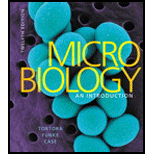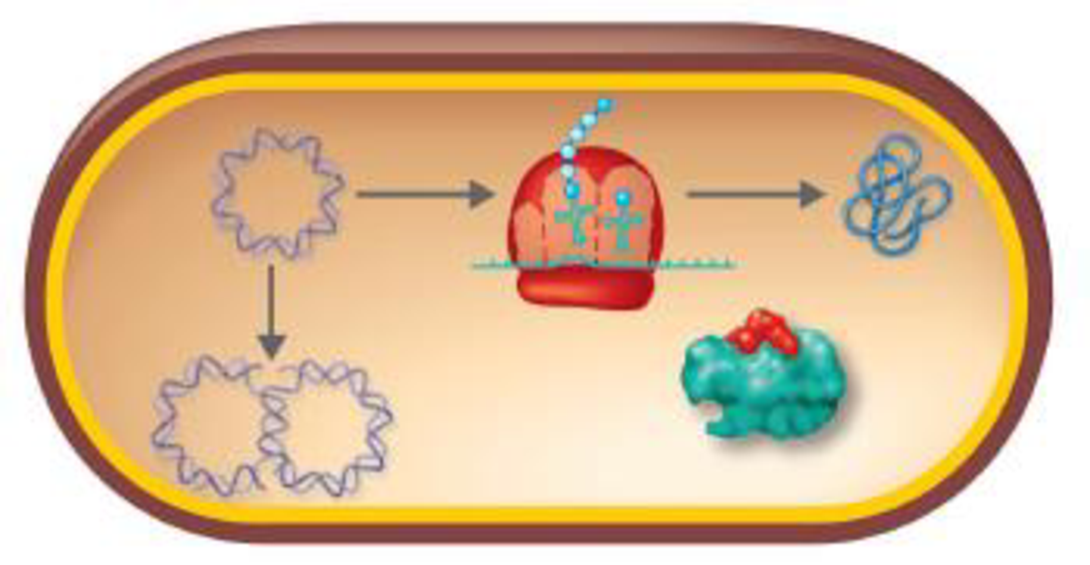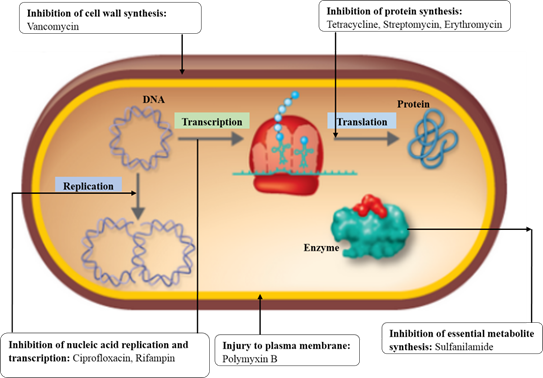
DRAW IT Show where the following antibiotics work: ciprofloxacin, tetracvcline, streptomycin, vancomycin, polymyxin B, sulfanilamide, rifampin, erythromycin.

To review:
Themode of action of given antibiotics in a bacterial cell.
Concept introduction:
The antibiotics can either act as a bacteriostatic (prevent growth of bacteria) or bactericidal (kill bacteria) agents. These drugs with a specific mode of action inhibits the essential biological processes of the target pathogen, including disruption of plasma membrane permeability, inhibition of cell wall, protein and nucleic acid synthesis, and inhibition of essential metabolites synthesis.
Answer to Problem 1R
Correct answer:
| ANTIBIOTICS | MODE OF ACTION |
| Ciprofloxacin | Inhibition of the nucleic acid replication |
| Tetracycline | Inhibition of the protein synthesis |
| Streptomycin | Inhibition of the protein synthesis |
| Vancomycin | Inhibition of the cell wall synthesis |
| Polymyxin B | Injury to the plasma membrane |
| Sulfanilamide | Inhibition of the essential metabolite synthesis |
| Rifampin | Inhibition of the nucleic acid transcription |
| Erythromycin | Inhibition of the protein synthesis |
Explanation of Solution
Diagram:

Explanation:
The mechanism of action of the given antibacterial drugs:
Ciprofloxacin – A broad spectrum of the bactericidal agent inhibits the bacterial enzyme DNA gyrase and blocks DNA synthesis. The DNA gyrase is an essential enzyme which is specifically involved in the introduction of negative supercoiling.
Tetracycline – A broad spectrum of the bacteriostatic agent prevents the attachment of aminoacyl tRNA from binding to bacterial 30S ribosome. By binding to the 30S subunit of bacterial ribosome, the tetracycline blocks the association of aminoacyl tRNA with the acceptor site.
Streptomycin – A broad spectrum of the bactericidal agent by acting on 70S ribosome inhibits the protein synthesis. It binds to the 30S subunit of bacterial ribosome and disrupts the protein synthesis (initiation and elongation step).
Vancomycin – A broad spectrum of the antibacterial agent inhibits the assembly of cell wall of bacteria. The N-acetylmuramic acid (NAG) and N-acetylglucosamine (NAM) monomers are the the building blocks of peptidoglycan cell wall. By binding to NAG and NAM, the vancomycin prevents the action of transpeptidase enzyme which is involved in the cross-linking of peptidoglycan.
Polymyxin B – A broad spectrum of the bactericidal agent with a cationic detergent action disrupts the permeability of the plasma membrane.
Sulfanilamide – A broad spectrum of the bacteriostatic agent acts as a competitive inhibitor of p-aminobenzoic acid (PABA). The sulfanilamide with a similar chemical structure competitively prevents the action of PABA and inhibits the folic acid biosynthesis. This arrests the bacterial growth and ultimately results in the elimination of the bacteria.
Rifampin – A broad spectrum of the bactericidal agent specifically inhibits the function of RNA polymerase in the bacteria. Rifampin forms a stable complex with the enzyme, thereby inhibits its activity in the nucleic acid transcription.
Erythromycin – A broad spectrum of the antibacterial agent inhibits the protein synthesis by binding to the bacterial 50S ribosome. It inhibits the activity of peptidyl transferase and intervenes with the amino acid translocation and protein assembly.
The specific site of action of the given antibacterial agents, namely cell wall synthesis (vancomycin), protein synthesis (tetracycline, streptomycin, erythromycin), essential metabolite synthesis (sulfanilamide), nucleic acid synthesis (ciprofloxacin), nucleic acid transcription (rifampin), and plasma membrane integrity (polymyxin B) is shown.
Want to see more full solutions like this?
Chapter 20 Solutions
Microbiology: An Introduction
Additional Science Textbook Solutions
Microbiology Fundamentals: A Clinical Approach
Chemistry & Chemical Reactivity
Chemistry: A Molecular Approach (4th Edition)
Cosmic Perspective Fundamentals
Biology: Life on Earth with Physiology (11th Edition)
- If you had an unknown microbe, what steps would you take to determine what type of microbe (e.g., fungi, bacteria, virus) it is? Are there particular characteristics you would search for? Explain.arrow_forwardavorite Contact avorite Contact favorite Contact ୫ Recant Contacts Keypad Messages Pairing ง 107.5 NE Controls Media Apps Radio Nav Phone SCREEN OFF Safari File Edit View History Bookmarks Window Help newconnect.mheducation.com M Sign in... S The Im... QFri May 9 9:23 PM w The Im... My first.... Topic: Mi Kimberl M Yeast F Connection lost! You are not connected to internet Sigh in... Sign in... The Im... S Workin... The Im. INTRODUCTION LABORATORY SIMULATION Tube 1 Fructose) esc - X Tube 2 (Glucose) Tube 3 (Sucrose) Tube 4 (Starch) Tube 5 (Water) CO₂ Bubble Height (mm) How to Measure 92 3 5 6 METHODS RESET #3 W E 80 A S D 9 02 1 2 3 5 2 MY NOTES LAB DATA SHOW LABELS % 5 T M dtv 96 J: ப 27 כ 00 alt A DII FB G H J K PHASE 4: Measure gas bubble Complete the following steps: Select ruler and place next to tube 1. Measure starting height of gas bubble in respirometer 1. Record in Lab Data Repeat measurement for tubes 2-5 by selecting ruler and move next to each tube. Record each in Lab Data…arrow_forwardCh.23 How is Salmonella able to cross from the intestines into the blood? A. it is so small that it can squeeze between intestinal cells B. it secretes a toxin that induces its uptake into intestinal epithelial cells C. it secretes enzymes that create perforations in the intestine D. it can get into the blood only if the bacteria are deposited directly there, that is, through a puncture — Which virus is associated with liver cancer? A. hepatitis A B. hepatitis B C. hepatitis C D. both hepatitis B and C — explain your answer thoroughlyarrow_forward
- Ch.21 What causes patients infected with the yellow fever virus to turn yellow (jaundice)? A. low blood pressure and anemia B. excess leukocytes C. alteration of skin pigments D. liver damage in final stage of disease — What is the advantage for malarial parasites to grow and replicate in red blood cells? A. able to spread quickly B. able to avoid immune detection C. low oxygen environment for growth D. cooler area of the body for growth — Which microbe does not live part of its lifecycle outside humans? A. Toxoplasma gondii B. Cytomegalovirus C. Francisella tularensis D. Plasmodium falciparum — explain your answer thoroughlyarrow_forwardCh.22 Streptococcus pneumoniae has a capsule to protect it from killing by alveolar macrophages, which kill bacteria by… A. cytokines B. antibodies C. complement D. phagocytosis — What fact about the influenza virus allows the dramatic antigenic shift that generates novel strains? A. very large size B. enveloped C. segmented genome D. over 100 genes — explain your answer thoroughlyarrow_forwardWhat is this?arrow_forward
- Molecular Biology A-C components of the question are corresponding to attached image labeled 1. D component of the question is corresponding to attached image labeled 2. For a eukaryotic mRNA, the sequences is as follows where AUGrepresents the start codon, the yellow is the Kozak sequence and (XXX) just represents any codonfor an amino acid (no stop codons here). G-cap and polyA tail are not shown A. How long is the peptide produced?B. What is the function (a sentence) of the UAA highlighted in blue?C. If the sequence highlighted in blue were changed from UAA to UAG, how would that affecttranslation? D. (1) The sequence highlighted in yellow above is moved to a new position indicated below. Howwould that affect translation? (2) How long would be the protein produced from this new mRNA? Thank youarrow_forwardMolecular Biology Question Explain why the cell doesn’t need 61 tRNAs (one for each codon). Please help. Thank youarrow_forwardMolecular Biology You discover a disease causing mutation (indicated by the arrow) that alters splicing of its mRNA. This mutation (a base substitution in the splicing sequence) eliminates a 3’ splice site resulting in the inclusion of the second intron (I2) in the final mRNA. We are going to pretend that this intron is short having only 15 nucleotides (most introns are much longer so this is just to make things simple) with the following sequence shown below in bold. The ( ) indicate the reading frames in the exons; the included intron 2 sequences are in bold. A. Would you expected this change to be harmful? ExplainB. If you were to do gene therapy to fix this problem, briefly explain what type of gene therapy youwould use to correct this. Please help. Thank youarrow_forward
- Molecular Biology Question Please help. Thank you Explain what is meant by the term “defective virus.” Explain how a defective virus is able to replicate.arrow_forwardMolecular Biology Explain why changing the codon GGG to GGA should not be harmful. Please help . Thank youarrow_forwardStage Percent Time in Hours Interphase .60 14.4 Prophase .20 4.8 Metaphase .10 2.4 Anaphase .06 1.44 Telophase .03 .72 Cytukinesis .01 .24 Can you summarize the results in the chart and explain which phases are faster and why the slower ones are slow?arrow_forward
- Essentials of Pharmacology for Health ProfessionsNursingISBN:9781305441620Author:WOODROWPublisher:Cengage
 Microbiology for Surgical Technologists (MindTap ...BiologyISBN:9781111306663Author:Margaret Rodriguez, Paul PricePublisher:Cengage LearningBasic Clinical Lab Competencies for Respiratory C...NursingISBN:9781285244662Author:WhitePublisher:Cengage
Microbiology for Surgical Technologists (MindTap ...BiologyISBN:9781111306663Author:Margaret Rodriguez, Paul PricePublisher:Cengage LearningBasic Clinical Lab Competencies for Respiratory C...NursingISBN:9781285244662Author:WhitePublisher:Cengage





